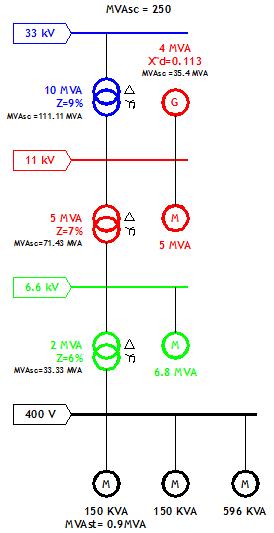In previous tutorials for the MVA method, we have discussed the importance of Short Circuit Study, combining KVAs and Short Circuit Calculations for three (3) phase and single phase faults. In this part of the tutorial, we will be discussing about Load Flow and Voltage Dips during motor starting.
We shall be using the same single line diagram as in the previous tutorial, except that the 2 x 150 MVa motors at the 400V Bus are now separate. We will calculate the Load Flow and Voltage dips for starting a 150MVA motor at the 400V Bus when all loads are running.

hi ver
where did 7.49 mva come from at the 11kv bus
PLEASE I NEED A PDF ebook with so many examples, on how to calculate load flow calculation using MVA method
@iam:
Do not be sorry, we encourage discussions here. It is a virtue to ask when unsure.
Thank you, the answer is on the article. I’m sorry i don’t read carefully.
Likely 0.9 from MVA Starting Motor, 0.15 and 0.596 from MVAsc Motor. where are 5.44; 2,97 ; 0,49 ; 1,98 came from?
May I have more explanations of Voltage Drop?
Thanks,
Dear Sir,
I apologize if i do not understand at items below,
for Vd = 2.97 / (2.97 + 0.9) = 76.7 % or 306.8 V
Where is 2.97 come from?
Thank you so much,
That value was taken from 5.44 * (0.9 / (0.9+0.15+0.596)) = 2.97
How to find Zero Sequence MVA:
if a synchronous motor (y/ wye and netral connected to gound ):
synchronous motor, nameplate: 2000KW ( 2.219MVA )
impedance ( xd”=15.38, x2=15.38, x0=15.38 )
dynamic model equivalent ( xd=110%, Xdu=116.93%, xd’=23%, XL=11% )
Locked rotor , LRC= 453.5%
pf =14.8%
grounding connection ( Y. type resistor )
Any information you could supply would be very welcome
Jonner
@orlyboy,
as they load are in parallel, the MVAs should be added. The answer was correct, it was a typo on the formula. Thanks for picking that up.
Sir,
How come the upstream value at 400V bus is 1.65 MVA?
As in the figure shows (1/0.9)+(1/0.15)+(1/0.596) = 9.4556
1/9.4556 is approximately 0.105757.
How come it is 1.65?
Kindly explain
Sir,
What is meant by MVA?
Is it Mega Volt Ampere or Mean Value Analysis?
Regards,
Orlyboy
I salute you sir for sharing your knowledge and expertise, thank you very much..god bless.
Hi artem,
I have updated the article. I hope it will be much clearer at this time.
Thanks
I’m sorry sir Ver but i have additional query about the voltage dip or voltage drop upon starting the motor 150kva on the system which draws a power of 0.9 MVA..I have a result by hand calculations at 400V Bus: 77.22%, at 6.6kV: 87.72%, at 11kV: 89.28% which is a little different result on your MVA Diagram as shown that at 400V Bus: 76.7% (shown calculation), at 6.6kV Bus: 80.6%, at 11kV Bus: 90% and 33kV Bus: 96.6%.
Please help me sir, how did you perform this calculations.. thank you..
exactly sir ver, this helps a lot. thank you very much..mabuhay ka and god bless.
Hi artem,
Here is how the values were taken.
Upstream Values:

The sum will be:
Downstream Values:

The sum will be:

Hope this helps.
@ 11kv bus as per mva diagram,
upstream values mva are 67.33 (transfo. 2) and 44.94 (motor 5mva)
downstream values mva are 8.55 (transfo. 1) and 3.94 (generator side)..
Please help me to explain sir how did these values came. How to perform this calculation…Thank you.
Hi Tiong,
Motor MVAs in load flow calculation is the rated motor MVA, not the short circuit MVA
Quoted” 1. Motor MVAs are equal to the rated Equivalent MVAs.”
I wish to confirm that Motor MVAs is the short circuit MVA please? Thank you